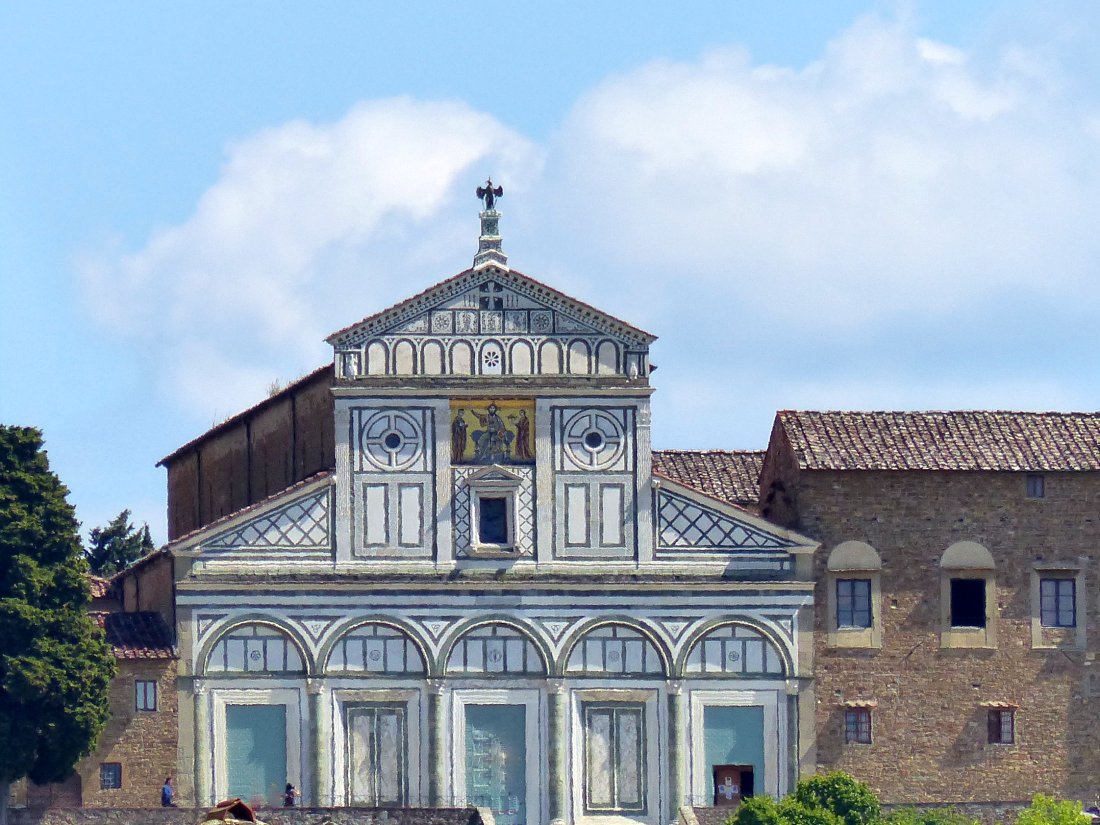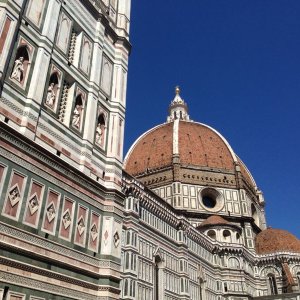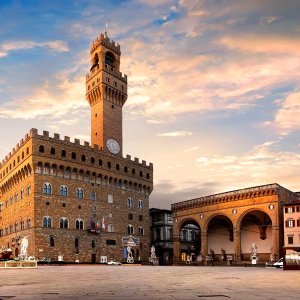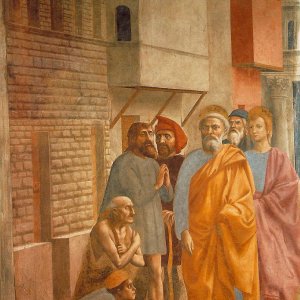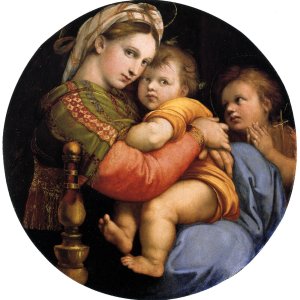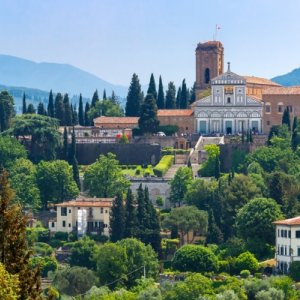Florence is the city at the heart of the Renaissance and has an overwhelming amount of art, architecture and historical locations that are worth seeing. So, with so much to see, how to you decide what to visit if time is tight and you only have a day or three to explore the city in?
Well, here's our entirely partisan list of the five sights not to miss if you're on a flying visit to the city. I'm going to slightly cheat - or perhaps be helpful - by linking each of these five places to other places that are nearby or on the way, so you can expand what you see depending on your timing.
And here is also a link to a beautiful apartment in the centre of the city, just in case you'd prefer to stay a little longer and see more of the city:
Via della Colonna, apartment for 2 to 4
Duomo di Brunelleschi
For the really time-pressed, this is one of the closest sights to the main Railway Station and is packed with Florentine history. The main Cathedral of Santa Maria del Fiore, commonly called the Duomo, was built to have the largest Dome since Roman times, larger even than the Pantheon. However, the city started construction, under Arnolfo di Cambio around 1296, before having the technical know-how to built such an enormous dome. The giant church was left without a roof for around a hundred years as the city searched for an architect or engineer capable of bridging the massive gap.
All sorts of solutions were proposed, including filling the space with earth to act as a support to the roof during construction, but scattering gold coins in the pile so that Florentine citizens themsleves would remove the earth while searching for the gold.
In 1334 Giotto, a famous painter and architect, was nominated as master of works. Unable to solve the conundrum of the dome, he designed the beautiful slender bell tower you will see next to the Cathedral.
Eventually Brunelleschi proposed a working solution that would work without buttresses or internal frames and that could be built as a self-supporting structure. It has an internal dome and an external one, with the internal dome doing most of the work. You can climb the Dome, wending up passages and stairways that fit in the gap between the two domes - it's well worth the climb. We used to go up here when playing truant from school and the views are fabulous! Look at the brick framework as you climb, you'll notice that the horizontal courses are regularly interrupted by bricks set vertically in order to stop the structure from twisting on itself under the massive weight of the thousands of bricks involved in the building.
If you're hungry it's worth walking to the "Mercato Centrale" near San Lorenzo for some fabulous eateries under a 19th century cast-iron structure.
Palazzo Vecchio and the Uffizi
Palazzo Vecchio is right in the centre of Florence - if you're walking to most of the other sights I've mentioned you're likely to walk past it, or close by. So of course it should be in a list of five things to see in Florence. Visiting the Uffizi may take a little more planning so is the optional extra - you can book and buy tickets online (see link) but sometimes you might not have managed this.
The Palazzo Vecchio (Old Palace) is the centre of secular power in Florence, in contrast to the Duomo of Santa Maria del Fiore as the centre of the city's religious power. Interestingly, both buildings were designed by Arnolfo di Cambio at the very end of the thirteenth century.
The spaces, paintings and sculptures of the Palazzo Vecchio chart the political history of the city, with the hand of the Medici seen nearly everywhere, but important political tumults also leave their mark, as in the "Salone dei Cinquecento", a giant and imposing chamber wanted by Savonarola as the seat of the Grand Council, after the Medici's had been exiled and Savonarola was establishing a 'popular' republic.
The Medici took back power after Savonarola was burned at the stake, and the chamber was enlarged and beautiful frescoes added to the walls. There is treasure after treasure in this building, and not enough space here - you can read more here: Palazzo Vecchio.
If you need to have a bite to eat, try Gustavino ini Via della Condotta.
The Uffizi are right next door - but you may well lose yourself in Palazzo Vecchio with so much to see.
Brancacci Chapel
This small chapel is in the Church of Santa Maria del Carmine in the Oltrarno - ie the "other side of the Arno" from the Duomo and the Palazzo Vecchio and was painted with a series of frescoes between 1425 and 1427 on commission to Felice Brancacci.
This cycle of frescoes is important as it uses to great effect the newly developed laws of perspective to show the space and places the figures within it. It is further striking as, together with this new construction of the spaces within the painting, it shows the protagonists with real human emotion.
Twelth century Tuscan paintings show figures as icons, as stiff representation of the ideas or figures they represent. Two centuries later Masaccio shows us real men and women carrying emotion in the set of their body and in their facial expressions. This cycle of frescoes shows us the development of humanism and the rising importance it attributes to knowledge, reality and the control that we might, through intellect and reason, exert over our world. This contrasts with the fatalism of late antiquity and marks the beginning of the Renaissance.
You can read more on the cycle of frescoes on wikipedia: Brancacci chapel.
Pitti Palace and the Galleria Palatina
A 20 minute walk will take you from the main railway station to the Pitti Palace, crossing the Arno river over the extraordinary Ponte Vecchio and its ancient jewellery workshops and heading south-west to the enormous stone structure. The core of the Palazzo was designed by Brunelleschi but most of what you see today, including the enormous stones of the lower floors, was designed by Bartolomeo Ammannati in 1560.
There are various galleries in the Palace, but I'll only mention my favourite, the Galleria Palatina, because it has some absolutely fabulous late-Renaissance pieces in it. One to head for is Raphael's "Madonna della Seggiola", a beautiful madonna and child showing amazing emotion.
When you've had enough of being indoors, head out to the Boboli Gardens, large formal gardens that climb the hills behind the palace. Look out for the naked fat man riding a tortoise close to the entrance from the Palace itself. There are vistas, statues and follies scattered around, it's a fabulous place to explore.
On your way back into town, walk down Via Maggio to explore the antiquarians' shops and cross the Arno over Ponte alla Carraia with a view of the Ponte Vecchio. Or if you'd like to pause in a wine-bar with some fabulous wines and good snacks, try "Le Volpi e l'Uva" in nearby Piazza dei Rossi.
Visit San Miniato al Monte
High above Florence close to Piazzale Michelangelo is the beautiful church of San Miniato al Monte, one of my all time favourites. Like many medieval churches San Miniato has an archaic mystical feel, with the mystery of the liturgy paramount in the spirit and design of the church. It sits on one of the highest points around Florence, with a beautiful view towards the Duomo and the Ponte Vecchio, and the Fortezza Belvedere to the left.
This is a long walk up a hill from the city centre, but you can start from the Ponte Vecchio and walk along Via de' Bardi, Via S. Niccoló and up to Piazzale Michelangelo, which itself has beautiful views of the city. On your way back you could stop at the Osteria Antica for a bite to eat.
The facade is an intricate intarsia of black, green and white marble started in the 11th century. The interior is similarly decorated, with more marble, intricately painted roof beams and rafters and richly decorated walls. The columns are re-used from old Roman structures, as was common before the 13th century, and are all different heights and width.
The present church dates mainly from the 11th and 12th centuries, though there has been a shrine here since the middle of the 3rd century.
The site is said to have been picked by Minias (San Miniato) himself, an Armenian prince who was beheaded for his Christian beliefs by the Roman Emperor Decius. Minias is said to have picked up his head and walked up the hill of Mons Fiorentinus to his hermitage.
You can visit the Cathedral, the Bell-tower and climb the Dome itself. It's also worth seeing the Baptistery, the beautiful octagonal building in front of the Duomo.
The giant loggia to the right of the Palazzo Vecchio is the Loggia dei Lanzi, built between 1376 and 1382. It was named after Cosimo I dei Medici used it to house his formidable German mercenary knights, the landsknechts, later corrupted and shortened to Lanzi.
St Peter healing the sick with his shadow - by Masaccio. Note the perspectival representation of a renaissance city, and the careful painting of the folds of Peter's robe. It is thought that the bearded man in the background is a portrait of Donatello.
There are many masterpieces in the Galleries of Pitti Palace, but the "Madonna della Seggiola" by Raphael is one of my favourites.
The basilica is considered one of the finest Romanesque structures in Tuscany and its hilltop position certainly makes it one of the most scenic.
